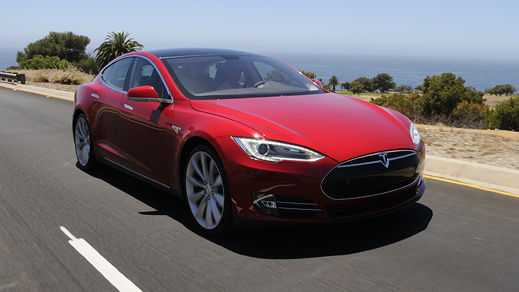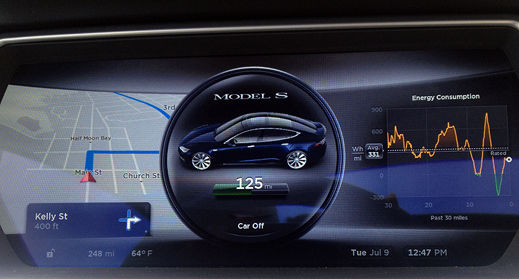On August 8th, Tesla Motors recently released its financial report for the second quarter of fiscal 2013. Its overall performance was higher than market expectations. Its stock price also rose by 13% after the close of trading. This year's share price has accumulated 347 points. %. It is clear that Tesla has grown into a dazzling new star in the automotive industry with constant innovation in the field of electric vehicles.
Kevin Bullis, senior editor of the MIT Technology Review magazine, has written an article on how Tesla has led the innovation of electric vehicles. The following are the main contents of the article.
I recently tested Tesla's Model S luxury electric car and visited Tesla's laboratories for research on battery and charging technology. This rare experience convinced me that Tesla had already achieved significant technical advantages. In the field of electric vehicles, it is ahead of other competitors.
The Model S is relatively expensive (from $70,000 to more than $100,000) and travels 426 kilometers, which is more than three times the Nissan Leaf (nearly 120 kilometers away). Tesla hopes manufacturing in the coming years a more affordable electric car, the price dropped 30,000 to $ 35,000 this interval, while Tesla also plans to build the United States covering the whole network of charging stations, convenience Waters Pulling the owner to charge, and achieve a half-hour charge to reach the goal of 320 kilometers.

Test Drive Model S
I scheduled a test drive route from Palo Alto, California headquarters of Tesla beginning, route of San Francisco, Half Moon Bay and Santa Cruz, then to the Tesla factory in Fremont to visit before returning to California Headquarters, a total of 370 kilometers throughout the trip.
However, when I received the Model S in Palo Alto, I discovered that the car was not fully charged. The battery showed only 335 kilometers, which is 426 kilometers below the standard S standard mileage. Even so, I still maintain it. The original route is unchanged, but in the middle may need to find a charging station.
Today's electric cars have several obvious advantages over ordinary cars. For passengers, there is no need to consider whether there are petrol stations along the way during driving. Just charge before the departure and the cost of charging is much lower than the cost of refueling. At the same time, electric vehicles only need a single gear to achieve all speeds, and their response speed and horsepower are also quite good. In addition, electric cars that do not use gasoline will not cause any pollution to the environment. Even if the pollution generated by power plants is counted, the carbon dioxide and ozone emissions associated with electric vehicles are only 40% of the conventional cars.
But even so, the development of electric vehicles is still subject to two key factors - high cost and low battery performance, which can be regarded as two problems that have long existed in the electric car industry.
What Tesla wants to solve is these two problems. The innovative battery and charging technology developed by the company not only effectively reduces the cost of the battery, but also has an ultra-fast charging speed, which makes Tesla ahead of other competitors. The main advantage.
At about 10 am, I drove off the parking lot at Tesla headquarters and started a Model S test drive. After experiencing the momentary acceleration performance of this luxury electric vehicle on the way, it takes only 1.7 seconds to accelerate from 0 to 48 km/h. At traffic lights such as crossroads, the start speed of the Model S is obviously better than that of most cars. Its climbing performance also left a deep impression on me.

However, when the battery was only able to run for 108 kilometers, I felt some worries. According to Model S's own estimate, the charging station closest to me at the time was located in Gilroy, 32 kilometers away. It is reasonable to say there was no problem with driving there, but What I am concerned about is that this is only an estimate of the vehicle's ideal state. Ultimately, it is also necessary to consider unknown factors such as driving habits, terrain and traffic conditions of the driver. Model S gives two estimation methods. One is similar to a fuel gauge on an ordinary car, and how much power can be displayed at any time; the other is based on the owner's power consumption in recent minutes. To be on the safe side, I turned off the air conditioner at the time, lowered the brightness of the 17-inch touch screen on the car, reduced the number of speed-increasing throttles, and finally arrived at the charging station with 27 kilometers left.
The Model S's charging process was much easier than I expected. I used half a day to complete the Chevrolet Volt charging at a standard public charging station, and the car was only able to run for 48 kilometers. When the Model S confirms the RFID tag on the charger handle, the charging port will automatically open and begin charging. Then I went to the parking lot opposite the charging station and bought a hamburger. I came back and found that the battery's capacity was able to run for 148 kilometers. It was basically enough to complete the test drive on that day. I talked with another owner of the Model S after driving for a while and continued on the road. At this time, the battery indicator could run 208 kilometers. This figure alone has already surpassed all the electric cars on the market, including Mercedes-Benz and BMW. The latest electric car.
Although EVs have achieved remarkable progress, the cost and driving distance still constrain its development. After all, these supercharged charging stations are not as widespread as gas stations. At present, there are only 16 countries in the United States. Such a charging station, at the same time, if the owner forgets to charge the car at night, or there is a power outage in the home, they may face a car-free dilemma the next day. In addition, if owners lost their way on the way, they would not dare to rush to consume limited amounts of electricity. They could only wait for help on the roadside.
However, the charging problem can be solved by increasing infrastructure construction. However, the cost of batteries is the biggest technical problem faced by electric vehicle companies. It is precisely this problem that limits the driving distance of Model S to 426 kilometers.
Visit Tesla R&D Lab
The day before my test drive, I visited the Tesla R&D laboratory near Stanford University. Tesla’s co-founder and Chief Technology Officer JB Straubel introduced me to the first electric vehicle Roadster they developed, and one car only retained the frame, wheels and power system (including the battery pack, Model S for electric motors and electronic control equipment). From the comparison of these two cars, we can see Tesla's breakthrough in technology. The Roadster's battery pack is very bulky, and it occupies almost one-third of the back end of the car. For S, at first glance, it is even hard to find the existence of battery packs and motors. The battery packs are tiled on the chassis, and almost all of them have been integrated into the chassis. However, the battery power and compactness of the Model S have long been exceeded. The Roadster, and the cost of batteries to hold electricity per kilowatt-hour, has also been cut in half.

Straubell has shown me various lithium-ion batteries, some of which are still in the test phase, including cylindrical batteries of the same size as the AA batteries used on the Model S.
Tesla's choice of small lithium-ion batteries as a power source for electric vehicles is one of its most important development strategies. Older car manufacturers often use larger battery packs when developing electric vehicles. The manufacturing process of these battery packs is The process is relatively simple and requires less manpower. However, large battery packs have a higher degree of danger due to higher stored power. Therefore, manufacturers rarely choose battery materials with high energy density and good fire resistance. They usually pass through. Reduce the energy density of battery materials to reduce manufacturing costs, and the direct consequence of this is that it is difficult for electric vehicles to obtain longer driving distances.
Tesla's choice of small batteries is somewhat similar to the notebook computer industry, and its manufacturing costs have fallen to a very low range under the influence of "scale economy." Because of the very low risk of small batteries, Tesla uses the highest energy density battery materials, which naturally lower battery costs. However, this also means that Tesla needs to connect thousands of small batteries to provide electric energy for electric vehicles. In addition, Straubell has also invented a serpentine water cooling system that can quickly dissipate the heat emitted by these small batteries, further increasing the safety factor of the battery pack.
The use of a cylindrical small battery also allows Tesla to have more flexibility in packing the battery pack. The flat battery is easily deformed in the event of a collision and may cause a fire, so car manufacturers often use batteries. Put in a relatively safe place (such as in the back seat or trunk) to avoid collisions, and Tesla is completely unconcerned about this situation, and their small batteries did not show deformation and leakage of coolant during the crash test.
According to most people's estimates, the battery cost of the Model S is between $42,500 and $55,250. Some people think that the battery cost is at least half of the total cost, but Strawbel said that the battery cost is not so high. "Actually, the battery cost Less than the total cost," he said, "is probably a quarter of the total cost." Strawbel also pointed out that if you put the production up, battery costs can be reduced even lower. Currently, he is working with battery and raw material manufacturers to increase the charge density of materials, and he is also trying to reduce the manufacturing difficulty by changing the shape of the battery.
Tesla's outstanding performance has attracted the attention of other automakers. According to reports, GM CEO Dan Akerson has set up a special team to conduct research on Tesla, a non-profit vehicle research institute. Brett Smith, deputy director of the Center for Automotive Research, said that Tesla, a maverick in the automotive industry, has become the darling of the media.
After coming out of the charging station in Gilroy, I drove the Model S on the highway back to San Francisco. Since I was walking within the charging station, I naturally experienced the unique charm of the electric car without worry. It is deeply felt that electric vehicles are the future of the automotive industry, and Tesla, which is constantly innovating, will undoubtedly be the backbone of the rapid development of electric vehicles.
High Precision Slitting Lines relate to narrow strip mini slitting machines, the narrow strip material can be CRC thin sheet, GI sheet, copper strip, HRC high carbon steel, etc. The mini slitter machine should be high precision, usually the recoilers of the mini Slitting Line are specially designed, such as coil inner diameters can be small 200mm, 300mm, 400mm, or big 600mm, etc.
We supply 1 x 630, 3 x 650, 1 x 405, 4 x 400 Mini slitting line to our customers, welcome you to consult.
Mini Slitter Machine,High Precision Mini Slitting Machine,Mini Slitting Machine,Steel Strip Mini Slitting Machine
Wuxi Jinye Hydraulic Pneumatic Complete Set Of Equipment Co.,Ltd. , https://www.jinye-machine.com